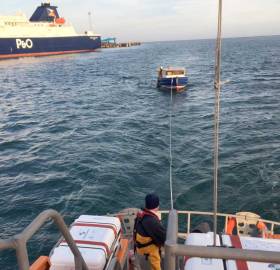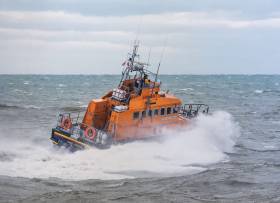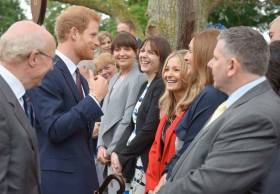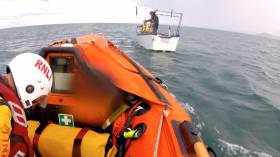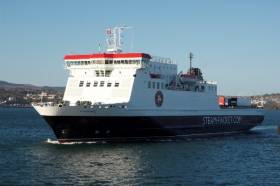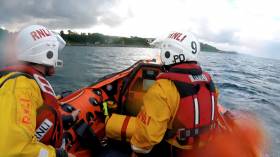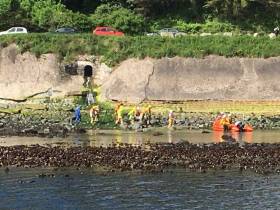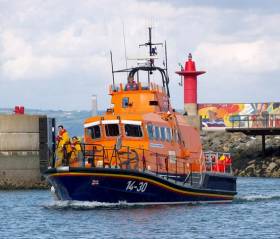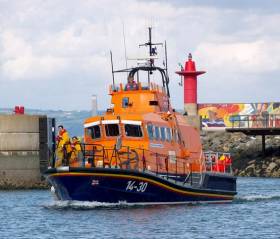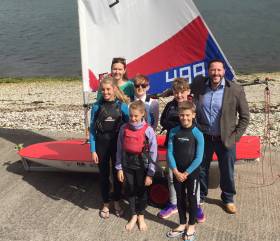Displaying items by tag: Larne
Larne Lifeboat Assists Two In Motorboat Breakdown Off Antrim Coast
#RNLI - Larne RNLI launched to the aid of two people on Monday morning (18 December) after their 33ft motorboat had engine difficulties en route from Carrickfergus to Greencastle.
The all-weather lifeboat Dr John McSparran was requested to assist the casualty vessel west of the Maidens and launched at 8.44am under coxswain Frank Healy and with five crew members.
Weather conditions at the time were described as dry with little swell.
Once on scene, volunteer crew member Michael Kane went aboard the casualty vessel and worked with the two sailors to establish a towline so that it could be brought into the shelter of Larne Harbour.
As the lifeboat was approaching the harbour, the inshore lifeboat Terry also launched to assist in bringing the vessel alongside Wymers Pier at East Antrim Boat Club.
Speaking following the callout, Healy said: “Both of the men onboard were fine and we were pleased to see they were both wearing their lifejackets.
“We would remind anyone using a motorboat to always have a means for calling for help, to always check the weather and tide times and to make sure someone ashore knows where you are going and who to call if you don’t return on time.”
Larne & Bangor Lifeboats Answer Pager Call During Storm Ophelia
#RNLI - Both Larne and Bangor RNLI were requested to launch last night (Monday 16 October) by Belfast Coastguard during Storm Ophelia.
The volunteer lifeboat crew pagers sounded at 9.25pm following reports of a person in the water at Whitehead off the Antrim coast.
Sea conditions at the time were very rough with winds gusting up to 60mph (97kmh).
As the Larne RNLI crew assembled and made preparations to leave the Port of Larne, Belfast Coastguard cancelled the launch following confirmation from the PSNI that two women were ashore safe and well.
Larne Coastguard, Portmuck Coastguard and the PSNI were also tasked to the incident.
Speaking later, Larne RNLI Coxswain Frank Healy said: “During what is extremely challenging weather conditions, I am proud to say 18 volunteers answered the call immediately. This demonstrates our crew dedication to help those in distress at sea.
“Our volunteer lifeboat crews will always launch to rescue those in danger at sea, but to launch into conditions like these could also put their lives at risk.
“I strongly urge people to respect the water and stay away from the coastline during the storm. If you do see someone else in trouble in the water, call 999 and ask for the coastguard. Don’t enter the water yourself as you could also end up in serious danger.”
Larne Lifeboat Volunteers Rub Shoulders With Royalty At Hillsborough Garden Party
#RNLI - Two couples who volunteer with Larne RNLI were chosen to represent the Co Antrim lifeboat station at the recent Hillsborough Garden Party where HRH Prince Harry was special guest.
Lifeboat crew Fiona and Barry Kirkpatrick attended the event at Hillsborough Castle in Co Down with deputy lifeboat launching authority Phil Ford-Hutchinson and his fundraiser wife Alison.
While there, the two couples were presented to Prince Harry by the Deputy Lieutenant of Co Antrim, Col Neil Salisbury OBE, and they chatted for a while about the busy lifeboat station and its work in the community.
“We were honoured to be asked to represent our lifeboat station and we met some incredible people at the event,” said Fiona Kirkpatrick. “We were introduced to HRH Prince Harry and of course took the opportunity to discuss our station and the work of our volunteer lifeboat crew and fundraisers in Larne.
“The prince was interested to know how many volunteers we had at our station and commented on how voluntary groups like the RNLI require a lot of hard work and commitment from a team.”
Three Launches In Three Days For Larne Lifeboats
#RNLI - It was a busy week for the volunteer crew at Larne RNLI last week with three launches for the Co Antrim lifeboats in three days.
On Tuesday 22 August, Larne’s all-weather lifeboat and inshore lifeboat were launched following a request from Belfast Coastguard after a small motor boat was reported overdue, having launched the previous day and making no contact since.
Following further information from Belfast Coastguard, the Larne inshore lifeboat made way to a motor boat north-west of the Number 1 buoy.
On making contact, it was confirmed the crew on board were those reported missing. All were well, with no engine difficulties, and they were able to make their way back to shore.
“It’s essential to have a clear plan when going to sea including checking the weather and tides before you leave and telling someone where you’re going and when you expect to be back,” said Larne RNLI helm Barry Kirkpatrick.
“If vessels do not return at the expected time we would urge members of the public to contact the coastguard by phoning 999 as soon as possible.”
The pagers sounded again on Wednesday 23 August at 6.15pm with reports of a 15ft motor boat with engine difficulties near Ballygally Head.
Larne RNLI’s inshore lifeboat crew were quickly on scene but no motor boat was visible in the Ballygally area. A search commenced and the vessel, with two men on board, was located three miles north-east of Ballygally head.
A tow was established and the boat taken to the safety of Tweeds Port in Carnfunnock.
“The casualty [vessel and crew were] located some distance off shore, unable to make their own way to safety,” said Larne RNLI deputy launching authority Philip Ford-Hutchinson. “We were pleased to see them wearing lifejackets and they made the correct decision in calling for help.
“We would encourage everyone going to sea to ensure your craft is in good condition, always wear a lifejacket and have a means of calling for help.”
On Thursday 24 August, both lifeboats were on exercise in Larne Lough with Mid and East Antrim Mayor Paul Reid and his wife Carol onboard when Belfast Coastguard tasked the all-weather lifeboat on service.
A member of the public reported an overturned vessel with four people on board in Drains Bay.
The lifeboat visitors were returned to shore and the all-weather lifeboat made its way to the scene, where the upturned vessels were found to be sea cadets performing capsize drills. This was a false alarm with good intent.
“This has been a busy week for our volunteer crew who drop everything to answer the call when their pagers sound,” said Larne RNLI coxswain Frank Healy. “Our crews are highly trained and skilled, and excellent team work ensured that all three launches were completed safely and successfully.”
Larne RNLI is currently looking for new volunteer crew members. If you have good general fitness, can work well in a team and have the ability to learn new skills, this role could be for you.
For further information and online application details, see the Larne Lifeboat Facebook page.
Manx Ferry 'Ben' Has Berthing Trial at Larne Harbour
#ferry- The Isle of Man Steam Packet has conducted berthing trials with Ben-my-Chree at Larne in Northern Ireland.
A similar exercise reports IOM Today was conducted with fast craft Manannan at Larne earlier this year and both vessels carried out berthing trials at Holyhead last year.
The Steam Packet said the trials have been carried out at part of general contingency planning.
Saturday night’s trial involved no disruption to services as the Ben-my-Chree was not scheduled to operate sailings that night.
For more on the story click here
See Trouble At Sea? Always Call For Help, Says Larne RNLI
#RNLI - Larne RNLI encourages the public to always call for help if they believe someone is in trouble on the coast, following a callout this week that turned out to be a false alarm.
The Larne volunteer crew launched their inshore lifeboat Terry on Thursday afternoon (20 July) following reports from a member of the public of an 8ft punt with two on board having engine difficulties in Drains Bay, Co Antrim.
Terry and crew were quickly on scene and found the vessel making way near Larne Promenade. The crew checked that the two people on board were not in distress and had a means of calling for help if need be.
“This incident proved to be a false alarm with good intent and we would like to thank the concerned member of the public who alerted the coastguard,” said Larne RNLI deputy launching authority Philip Ford-Hutchinson.
“We would encourage anyone taking to the water to always wear a life jacket, ensure your vessel and equipment are in good working order, check the weather and tide and always carry a means of calling for help. If you see someone in trouble on the coast always dial 999 and ask for the coastguard.”
#RNLI - Larne RNLI was involved in a multi-agency rescue yesterday afternoon (Sunday 16 July) after a cyclist fell between as much as 15 feet from the Coast Road north of Ballygally in Co Antrim.
The volunteer crew were requested to launch both their all-weather and inshore lifeboats at 10.15am following a report from Belfast Coastguard that the cyclist had fallen down a steep slope onto a rocky shore half a mile north of Ballygally.
Larne and Ballycastle Coastguard also responded along with personnel from both the fire and rescue service and the ambulance service.
Weather conditions were good at the time of the launch, with a north-westerly wind and a calm sea.
Once on scene, two crew members from the all-weather lifeboat went ashore with the inshore lifeboat crew to help with moving the the casualty from the beach.
The cyclist was assessed by a doctor and paramedic from the ambulance service, and a decision was made to transfer him from the beach via the inshore lifeboat to the care of ambulance personnel.
Speaking following the callout, Larne RNLI helm Pamela Leitch said: “Due to the nature of the cyclist’s fall, the position for extraction was challenging via land and the best decision was to remove him from the beach side.
“We would like to wish the cyclist a speedy recovery following what must have been a frightening experience for him. Today’s call out was a great example of different agencies working well together to bring someone to safety.”
#RNLI - Larne RNLI responded to two consecutive calls for help off the Antrim coast yesterday afternoon (Saturday 8 July).
The volunteer lifeboat crew was requested to launch their all-weather and inshore lifeboats at 2.17pm after Belfast Coastguard reported that a red survival suit was seen floating on the water.
Weather conditions were described as good at the time with clear visibility. Beaches were busy and there were several boats on the water.
The all-weather lifeboat under coxswain Chris Dorman and the inshore lifeboat helmed by Pamela Leitch launched and made their way to the area two miles south east of Hunter’s Buoy.
Together the lifeboats conducted a parallel search north for two miles in the direction of the tide before the inshore lifeboat crew spotted the object one mile into the search and recovered what turned out to be a fishing floatation suit from the water.
On passage back to Larne at approximately 3.15pm, the lifeboats were requested a second time by the coastguard, this time to follow up a report from a member of the public that a blue kayak had been spotted out of Portmuck Harbour.
The crew proceeded to the area and conducted a search but no one or nothing was found. The lifeboats were stood down on the understanding that the callout was a false alarm with good intent.
Larne RNLI coxswain Chris Dorman later commented: “While today’s call outs didn’t involve people being rescued, we would remind anyone who is enjoying the good weather and taking to the sea for activities at this busy part of the summer season to always respect the water.
“Plan your trip carefully mindful of the weather and tide times. Always wear a lifejacket and carry a means of communication. If you happen to lose a piece of equipment or clothing, please report it and should you or someone you see get into difficulty call 999 or 112 and ask for the coastguard.”
Earlier this week Larne RNLI were called to rescue two men on a yacht stranded by a fouled propeller, as previously reported on Afloat.ie.
Larne Lifeboat Rescue Two After Yacht Becalmed With Tangled Propeller Off Antrim Coast
#RNLI - Larne RNLI rescued two men yesterday afternoon (Wednesday 5 July) after their yacht got into difficulty off the Antrim coast.
The all-weather lifeboat was requested to launch at 1.46pm following a report from Belfast Coastguard that a 30ft yacht with two people on board had got into difficulty two miles east of Muck Island.
The lifeboat, under coxswain Frank Healy, launched immediately and made its way to the scene. Weather conditions were good at the time with a Force 1 wind and clear visibility.
A fisheries protection vessel was on scene first and assisted the VHF communications between the lifeboat and casualty vessel.
Upon arrival, the volunteer lifeboat crew observed that the yacht, which had been on passage between Bangor and Campbeltown, had got its propeller tangled on fishing nets. A lack of wind had left the sailors with no means of moving forward.
The lifeboat crew worked to establish a towline and proceeded to take the vessel under tow to Larne Lough where it was met by Larne’s inshore lifeboat, which assisted in helping the yacht onto a mooring.
Dolphins that were in the area at the time also guided the vessel into the harbour.
Speaking following the callout Larne RNLI’s deputy launching authority Roy McMullan reminded anyone taking to the sea this summer to respect the water.
“Sailing and motorboating are popular pastimes particularly at this time of year. We would encourage sailors to always wear a lifejacket and always have a means for calling or signalling for help and ensure everyone onboard knows how to use it.
“Always check the weather forecast and tide times and make sure someone ashore knows where you are going and who to call if you don’t return on time.”
With only days to go, the countdown towards the Topper Irish National Championships - now in its 30th year - has started in earnest.
East Antrim Boat Club are the hosts and the leading LED signage and marketing company Blazin Digital are the sponsors for this all-Ireland youth extravaganza.
The championship, which will be sailed on the expanses of Larne Lough, runs from 7th to 9th July. It has already attracted huge interest with over 50 online entries already confirmed. Competitors will be travelling from across the provinces of Ireland, as well as from various GB based Topper fleets.
At the launch of this Topper championship East Antrim's Commodore Stephen Craig said; "We are honoured to be awarded this prestigious event and delighted to be alongside the Topper family again. We of course welcome aboard our principal, and very generous sponsor, Blazin Digital." He continued, "EABC's Topper fleet will be led out by Rory Williamson, our newest champion sailor.
Rory brought home the Topper Southern title recently. Finally, and on behalf of the membership here at EABC, I send a welcome to the competitors their families and supporters. Let me also take this opportunity to thank all of our club volunteers, and indeed the support of our neighbouring clubs, without whom this event would not be possible."
The final words are from the thirteen-year-old Topper Southern Champion, EABC's Rory Williamson; "I am really excited that the Irish Nationals are being held at East Antrim Boat Club. To get a good result at my own club would be fantastic so I will be trying my hardest to place well. I am looking forward to not only racing with my fellow Irish sailors but also some of my friends from England, Scotland and Wales. I think it is going to be an amazing few days of racing. BRING IT ON!"



























